AND YOU ARE WHO?
 What’s in a name?
What’s in a name?
Almost everyone who staged up beside Steve Paulauskis, crew chief Kelly Bluebaugh, and the rest of the WFO Motorsport team found out first hand during the 2006 season.
Once just the moniker Bluebaugh gave to his one-man nitrous engine and machine shop, WFO Racing and Machine, located in Phoenix, AZ, the WFO stable has grown to include Bluebaugh’s own ‘World’s Fastest Citation’ and most recently the Chevy Cavalier of 2006 Pacific Street Car Association Pro Street Champion Steve Paulauskis.
Steve Paulauskis and WFO burst onto the Pro Street scene
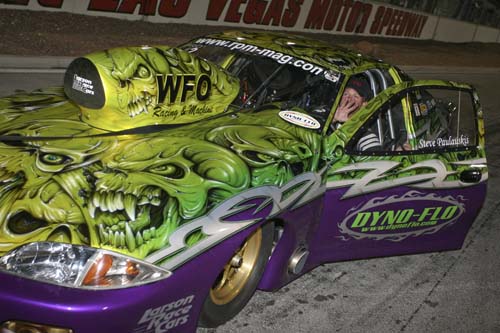
What’s in a name?
Almost everyone who staged up beside Steve Paulauskis, crew chief Kelly Bluebaugh, and the rest of the WFO Motorsport team found out first hand during the 2006 season.
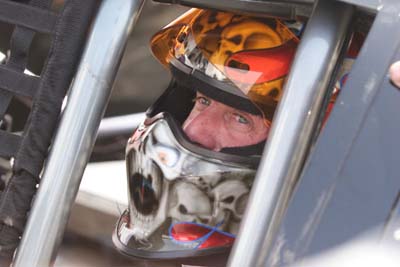 Once just the moniker Bluebaugh gave to his one-man nitrous
engine and machine shop, WFO Racing and Machine, located in Phoenix, AZ, the
WFO stable has grown to include Bluebaugh’s own ‘World’s Fastest Citation’ and
most recently the Chevy Cavalier of 2006 Pacific Street Car Association Pro
Street Champion Steve Paulauskis.
Once just the moniker Bluebaugh gave to his one-man nitrous
engine and machine shop, WFO Racing and Machine, located in Phoenix, AZ, the
WFO stable has grown to include Bluebaugh’s own ‘World’s Fastest Citation’ and
most recently the Chevy Cavalier of 2006 Pacific Street Car Association Pro
Street Champion Steve Paulauskis.
With that championship came a wave of newfound notoriety among the fast doorslammer community. Almost overnight WFO went from a small West Coast novelty to one of the most talked about Pro Street teams in the country. But with that notoriety also came a small amount of controversy, whether it be the team’s sudden success or the WFO name itself.
“To us the WFO name symbolizes our ‘never quit, never say
die’ attitude and work ethic,” said Bluebaugh. “It’s not so much a literal
translation, but more of a way of doing things.”
Another name associated with WFO, and to whom they credit a portion of their
recent success, also created a bit of a stir among the PSCA and Pro Street crowd
this season.
Bluebaugh brought in none other than Pro Mod legend Charles Carpenter as the team’s engine supplier, tuner, and team consultant for the 2006 season. The results speak for themselves, showing the partnership paid instant dividends. But this working relationship was formed long before the 2006 season.
“I met Charles back in the 1980s when he was running the Super Chevy circuit. I used to pester the daylights out of him for information. He was one of the first ones out there running fast with nitrous, so to me he was definitely the man to try to learn from,” said Bluebaugh. “Now I look back on it and think how he would probably run for cover when he saw me coming.”
a d v e r t i s e m e n t
Click to visit our sponsor's website
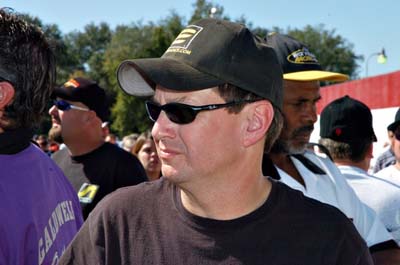 Carpenter and Bluebaugh stayed in contact through the years,
until the late 1990s when Bluebaugh was ready to step up and run Outlaw 10.5 in
his Chevy Citation. He only had one person in mind to provide the needed power.
He purchased a 632-cubic-inch Gene Fulton powerplant from Carpenter and flew
him out to the West Coast to tune the engine, which resulted in a preliminary
gain in the half-second range. Eventually this engine and tune-up propelled the
Citation to an unbelievable 7.23 at 195 mph, the quickest run ever seen in the
class at the time.
Carpenter and Bluebaugh stayed in contact through the years,
until the late 1990s when Bluebaugh was ready to step up and run Outlaw 10.5 in
his Chevy Citation. He only had one person in mind to provide the needed power.
He purchased a 632-cubic-inch Gene Fulton powerplant from Carpenter and flew
him out to the West Coast to tune the engine, which resulted in a preliminary
gain in the half-second range. Eventually this engine and tune-up propelled the
Citation to an unbelievable 7.23 at 195 mph, the quickest run ever seen in the
class at the time.
Shortly thereafter Kelly was looking to move up yet again, this time to Pro Street. “I always knew if I had the opportunity to get my hands on one of Carpenter’s more recent engines, we would be tough to handle in Pro Street,” Bluebaugh said.
That opportunity presented itself in the form of Phoenix-area landscaping entrepreneur and all-around speed freak Steve Paulauskis.
After a season and a half driving Bluebaugh’s Citation, Paulauskis’ wife urged him to purchase his own Pro Street car. Thanks to a recommendation by carburetor guru Dale Cubic, Paulauskis purchased the ex-Kenny Benso 2004 Cavalier built by Larry Larson. “Steve and I met up with Larry at the 2005 PRI show to discuss the changes and updates that needed to be made to the car to accommodate the power and weight we were going to throw in it,” Bluebaugh said. “From there it was a simple walk across the convention hall to the Embee Performance booth to talk to Charles about getting a new motor.”
In the months that followed, everything was prepared at Larson Race Cars in Oak Grove, Missouri. Further befitting the WFO name and showing they were not taking the upcoming 2006 season lightly, Bluebaugh and Paulauskis arranged a test session at Speedworld in Phoenix with their team of experts in attendance: Larry Larson to set up the chassis, Dale Cubic to tweak the carburetors, and Charles Carpenter to tune the nitrous and give Paulauskis driving tips.
But as it turned out, Paulauskis didn’t need a whole lot of coaching. He got his start in drag racing on the streets and eventually went high-speed go-kart racing, winning 4 championships and numerous Driver of the Year wards. He decided to make a return to drag racing, but this time on the strip. Bluebaugh talked him into putting a nitrous powered big-block in his 1964 Nova, and the rest is history; Steve has gone from running 10s in a modified street car to 6.40s at 220 mph in a former Pro Stock car in just two years. Someone without Paulauskis’ uncanny driving ability may not have accomplished this feat.
a d v e r t i s e m e n t
Click to visit our sponsor's website
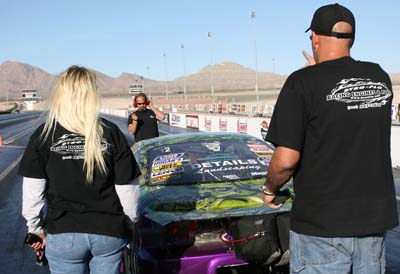 “He (Paulauskis) is one of the most talented drivers and
quickest learners I have come across in a long time,” Carpenter said. “He’s a
natural and has the total package. He can drill you on the tree, pedal it, and
just flat out drive with the best of them.”
“He (Paulauskis) is one of the most talented drivers and
quickest learners I have come across in a long time,” Carpenter said. “He’s a
natural and has the total package. He can drill you on the tree, pedal it, and
just flat out drive with the best of them.”
In addition to all these components, critical contributions to Paulauskis’ success have come from the rest of the WFO team and their sponsors, such as Dyno-Flo and SI Valves.
Assisting Bluebaugh in tuning the Cavalier is his girlfriend Deborah Woodard, whom Kelly calls “the brains of the operation.” A former employee at the General Motors Desert Proving Ground in Arizona, Woodard, who studied engine theory, keeps meticulous records of every pass and everything that is going on with the Cavalier. She has been around fast cars and engines for a long time, but attributes much of her recent knowledge to watching Carpenter at work. “Charles first showed me how to tune the car for the weather and how it affects fuel, timing, and the nitrous tune-up,” said Woodard. “He has given Kelly and I a lot of insight over the years. He is very creative with his tuning abilities and it gives us a real competitive edge.”
The rest of the crew consists of Bill Kincaid, the team’s all-around specialist, and Wally Tuttle, both Senior and Junior. Wally Sr. has been on the drag racing scene since the 1950s, crewing with greats like Chris “The Greek” Karamesines. He is the team’s eagle eye, watching over everything and ensuring all between-round maintenance is performed. An aerospace prototype machinist by trade, he does a lot of custom fabrication for the team as needed. His son, Wally Jr., also is an accomplished fabricator. The WFO clutch man, Wally Jr. is the former crew chief for Butch Lee and the Bowtie Bullet Pro Mod team.
The WFO MotorSport team grew tremendously and experienced a great deal of success during the 2006 season. But that success didn’t come without adversity.
After a string of No. 1 qualifying positions and event wins on the PSCA circuit, the team suffered catastrophic engine damage at the PSCA Fall Nationals in Fontana, California. During the first round of qualifying, something wasn’t right at the end of the run. “During the first round of qualifying, there was a small blast of sparks under the car just shy of half-track,” recalled Woodard. “Sometimes the starter teeth hit the flywheel and it creates sparks under the car during the run, but this was on the wrong side. It just looked different.” The difference was that the engine block had been completely split in half by a crankshaft failure, an eerily similar situation to that which Carpenter faced late last season.
Of course this left the team devastated, and without an engine heading into the biggest events of the year. But as luck would have it, Carpenter had recently acquired a brand new engine from Fulton’s Spartanburg, South Carolina shop, and the one he had been running all season was for sale. Paulauskis had to get creative, but he came up with the funds needed to acquire the new bullet.
a d v e r t i s e m e n t
Click to visit our sponsor's website
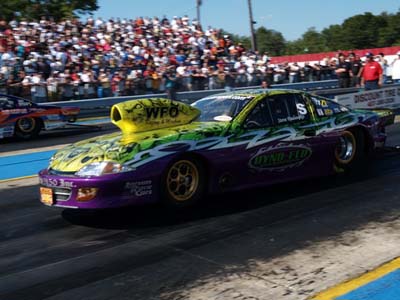 “We headed to the biggest street car race of the year, the
World Street Nationals in Orlando,
without an engine,” said Woodard. “Charles drove down to Orlando
from North Carolina
with the new piece, and installed it in the Cavalier the day before the race
with the help of Kelly and Wally Sr.”
“We headed to the biggest street car race of the year, the
World Street Nationals in Orlando,
without an engine,” said Woodard. “Charles drove down to Orlando
from North Carolina
with the new piece, and installed it in the Cavalier the day before the race
with the help of Kelly and Wally Sr.”
The new engine picked up right where the old one left off, propelling Paulauskis to the No. 9 qualifying position and a quarterfinal finish. He also matched Vinny Budano with the quickest elapsed time for a nitrous powered entry at the event.
From there the team headed back to the West Coast, where they knocked off longtime Pro Mod driver John Scialpi in the final round to take the win at the PSCA’s season ending race in Fontana. In the process they lowered their personal elapsed time record to 6.44 at 219 mph, and wrapped up their first Pro Street championship.
Paulauskis, Bluebaugh, and WFO were back on track. But the string of success was interrupted by another unfortunate event, this time heading into the $20,000-to-win Street Car SuperNationals at Las Vegas Motor Speedway. WFO suddenly became an acronym for “Wheel Fell Off” or “Weld Fender On” as Paulauskis dumped the clutch on a pass during Thursday night’s test and tune. “The car left the line really hard, and continued to climb the wheelie bars as I ran through low gear,” said Paulauskis. “Then it went into some of the most violent tire shake I have ever felt.”
All the power the new engine was producing and the out-of-this-world traction of the LVMS quarter-mile combined to create a force that snapped the rear axle right behind the left wheel center. The car crashed back down to earth, and the left Goodyear slick ripped straight through the fender, rear bumper, wing, and the immaculate paint job that adorns the Cavalier. Paulauskis guided the three-wheeled car to a safe stop as the loose tire rolled down the track past him.
“But, as I stated earlier, WFO is all about a never-quit attitude,” said Bluebaugh. “Thanks to the quick work of Larry Larson, our crew, and everyone else who chipped in, we were able to get it repaired. No way were we not going to be racing on Sunday.”
a d v e r t i s e m e n t
Click to visit our sponsor's website
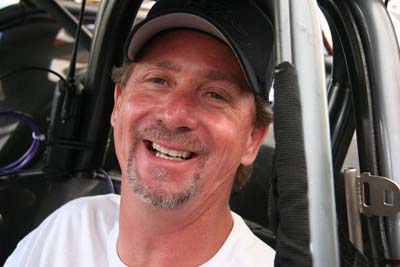 Although it took all of Friday and it certainly wasn’t
pretty, WFO was back on the track for Saturday’s qualifying sessions. The team
missed the setup during their two qualifying shots, but made the field in the
No. 23 spot. Paulauskis marched through eliminations on Sunday, taking out
rival and 3-time PSCA champion Ed Thornton, Pro RWD champion Brad Personett,
and Pro Mod veteran Dennis Radford to set up a dream match-up with NMCA
champion and East Coast hitter Vinny Budano.
Although it took all of Friday and it certainly wasn’t
pretty, WFO was back on the track for Saturday’s qualifying sessions. The team
missed the setup during their two qualifying shots, but made the field in the
No. 23 spot. Paulauskis marched through eliminations on Sunday, taking out
rival and 3-time PSCA champion Ed Thornton, Pro RWD champion Brad Personett,
and Pro Mod veteran Dennis Radford to set up a dream match-up with NMCA
champion and East Coast hitter Vinny Budano.
With Carpenter looking on, Paulauskis nailed Budano off the line by a tenth of a second, but Budano proved why he is one of the top Pro Street racers in the nation, chasing down Paulauskis and taking the win by a narrow two-hundredths of a second margin.
“The runner-up finish at Vegas left us hungry for next season,” Bluebaugh said. “We had a great year and accomplished just about everything we set out to do, but we want more. We got the West Coast’s attention this season. With the continued support of our sponsors and everyone else who helped us get here, we want to get the whole nation’s attention.”
Twice battling back from catastrophic failure, setting records, winning races, and earning a championship in your first season is a sure-fire way to grab some attention. It’s also how the WFO Motorsport team illustrates what truly is in a name.
| {loadposition feedback} |






